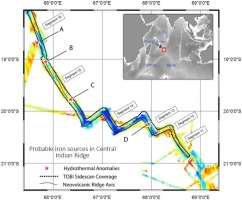当前位置:
X-MOL 学术
›
Chem. Geol.
›
论文详情
Our official English website, www.x-mol.net, welcomes your
feedback! (Note: you will need to create a separate account there.)
Distribution of iron in the Western Indian Ocean and the Eastern tropical South pacific: An inter-basin comparison
Chemical Geology ( IF 3.6 ) Pub Date : 2020-01-01 , DOI: 10.1016/j.chemgeo.2019.119334 James W. Moffett , Christopher R. German
Chemical Geology ( IF 3.6 ) Pub Date : 2020-01-01 , DOI: 10.1016/j.chemgeo.2019.119334 James W. Moffett , Christopher R. German

|
Abstract The Western Indian Ocean (WIO) and Eastern Tropical South Pacific (ETSP) are distinctly different regimes, yet they share several important features. These include a strong upwelling system, a large oxygen minimum zone (OMZ) with active denitrification, a spreading center with extensive hydrothermal activity, and a vast oligotrophic upper water column. Here, we show that the distribution and geochemistry of iron shows remarkable similarities as well. In particular, both basins exhibit large sub-surface plumes of iron derived from sediments underlying the oxygen minimum zones and from hydrothermal sources. Moreover, the behavior of Fe, especially its redox cycling, is remarkably similar in the Arabian Sea and Peruvian oxygen minimum zone, reflecting similar processes associated with the nitrogen cycle in each region. The large Fe plumes under each OMZ are well below the oxygen-free depth, yet they are probably dependent on internal redox cycling and scavenging of Fe within the overlying OMZs. Globally, both the Arabian Sea and Peru margin sediments are hot spots of carbon oxidation, which probably contributes to their importance as Fe sources. The fate of hydrothermally derived Fe in the WIO and ETSP is particularly interesting to compare because their source terms are very different even though their oxidation rates, once they have entered the water column, should be directly comparable. In the ETSP, hydrothermal inputs from along a section of the ultra-fast spreading Southern East Pacific Rise (SEPR) are integrated into a single coherent plume that is exported west across the ocean interior for >4000 km. In contrast, hydrothermal inputs to the WIO derive from multiple sources including outflow from the Red Sea via the Gulf of Aden, the Indonesian Throughflow, and from multiple vent-sources along the Carlsbad Ridge, Central Indian Ridge and SW Indian Ridge which are slow, medium and ultra-slow spreading, respectively. As a result, hydrothermally sourced Fe distributions are more complex in the WIO, with several overlapping plumes and distinctly different distributions of two other hydrothermally-derived metals, aluminum and manganese. Here we argue that comparative studies of these basins, with a future emphasis on benthic-water column interactions, will advance knowledge about Fe biogeochemistry and how distributions in the WIO, in particular, are likely to change in the future.
中文翻译:

西印度洋和东热带南太平洋铁的分布:跨流域比较
摘要 西印度洋 (WIO) 和东热带南太平洋 (ETSP) 是截然不同的区域,但它们有几个重要特征。其中包括强大的上升流系统、具有活跃反硝化作用的大型最低氧区 (OMZ)、具有广泛热液活动的扩展中心以及巨大的贫营养上部水柱。在这里,我们表明铁的分布和地球化学也表现出显着的相似性。特别是,这两个盆地都表现出大量的地下铁羽流,这些铁羽来自最低氧区下方的沉积物和热液源。此外,Fe 的行为,尤其是其氧化还原循环,在阿拉伯海和秘鲁最低氧区中非常相似,反映了与每个区域的氮循环相关的相似过程。每个 OMZ 下的大 Fe 羽流远低于无氧深度,但它们可能依赖于内部氧化还原循环和上覆 OMZ 内 Fe 的清除。在全球范围内,阿拉伯海和秘鲁边缘沉积物都是碳氧化的热点,这可能有助于它们作为铁源的重要性。比较 WIO 和 ETSP 中热液衍生的 Fe 的命运特别有趣,因为它们的来源条件非常不同,即使它们的氧化速率一旦进入水体就应该直接比较。在 ETSP 中,来自超快速扩张的南东太平洋海隆 (SEPR) 的一部分的热液输入被整合成一个单一的连贯羽流,向西输出超过 4000 公里的海洋内陆。相比之下,WIO 的热液输入来自多种来源,包括通过亚丁湾从红海流出、印度尼西亚的贯穿流,以及来自卡尔斯巴德海岭、中印度海脊和西南印度海脊的多个喷口源,这些热液是缓慢、中度和超- 缓慢传播,分别。因此,WIO 中热液来源的 Fe 分布更复杂,有几个重叠的羽流和另外两种热液衍生的金属铝和锰的明显不同的分布。在这里,我们认为对这些盆地的比较研究,未来将重点放在底栖水柱相互作用上,将推进关于铁生物地球化学的知识,特别是在未来 WIO 中的分布可能会如何变化。印度尼西亚贯穿流,以及沿卡尔斯巴德海岭、中印度海岭和西南印度海脊的多个喷口源,分别是缓慢、中速和超慢速扩张。因此,WIO 中热液来源的 Fe 分布更复杂,有几个重叠的羽流和另外两种热液衍生的金属铝和锰的明显不同的分布。在这里,我们认为对这些盆地的比较研究,未来将重点放在底栖水柱相互作用上,将推进关于铁生物地球化学的知识,特别是在未来 WIO 中的分布可能会如何变化。印度尼西亚贯穿流,以及沿卡尔斯巴德海岭、中印度海岭和西南印度海脊的多个喷口源,分别是缓慢、中速和超慢速扩张。因此,WIO 中热液来源的 Fe 分布更复杂,有几个重叠的羽流和另外两种热液衍生的金属铝和锰的明显不同的分布。在这里,我们认为对这些盆地的比较研究,未来将重点放在底栖水柱相互作用上,将推进关于铁生物地球化学的知识,特别是在未来 WIO 中的分布可能会如何变化。水热来源的铁分布在 WIO 中更为复杂,有几个重叠的羽流和另外两种水热衍生的金属铝和锰的明显不同的分布。在这里,我们认为对这些盆地的比较研究,未来将重点放在底栖水柱相互作用上,将推进关于铁生物地球化学的知识,特别是在未来 WIO 中的分布可能会如何变化。水热来源的铁分布在 WIO 中更为复杂,有几个重叠的羽流和另外两种水热衍生的金属铝和锰的明显不同的分布。在这里,我们认为对这些盆地的比较研究,未来将重点放在底栖水柱相互作用上,将推进关于 Fe 生物地球化学的知识,特别是 WIO 中的分布在未来可能会如何变化。
更新日期:2020-01-01
中文翻译:

西印度洋和东热带南太平洋铁的分布:跨流域比较
摘要 西印度洋 (WIO) 和东热带南太平洋 (ETSP) 是截然不同的区域,但它们有几个重要特征。其中包括强大的上升流系统、具有活跃反硝化作用的大型最低氧区 (OMZ)、具有广泛热液活动的扩展中心以及巨大的贫营养上部水柱。在这里,我们表明铁的分布和地球化学也表现出显着的相似性。特别是,这两个盆地都表现出大量的地下铁羽流,这些铁羽来自最低氧区下方的沉积物和热液源。此外,Fe 的行为,尤其是其氧化还原循环,在阿拉伯海和秘鲁最低氧区中非常相似,反映了与每个区域的氮循环相关的相似过程。每个 OMZ 下的大 Fe 羽流远低于无氧深度,但它们可能依赖于内部氧化还原循环和上覆 OMZ 内 Fe 的清除。在全球范围内,阿拉伯海和秘鲁边缘沉积物都是碳氧化的热点,这可能有助于它们作为铁源的重要性。比较 WIO 和 ETSP 中热液衍生的 Fe 的命运特别有趣,因为它们的来源条件非常不同,即使它们的氧化速率一旦进入水体就应该直接比较。在 ETSP 中,来自超快速扩张的南东太平洋海隆 (SEPR) 的一部分的热液输入被整合成一个单一的连贯羽流,向西输出超过 4000 公里的海洋内陆。相比之下,WIO 的热液输入来自多种来源,包括通过亚丁湾从红海流出、印度尼西亚的贯穿流,以及来自卡尔斯巴德海岭、中印度海脊和西南印度海脊的多个喷口源,这些热液是缓慢、中度和超- 缓慢传播,分别。因此,WIO 中热液来源的 Fe 分布更复杂,有几个重叠的羽流和另外两种热液衍生的金属铝和锰的明显不同的分布。在这里,我们认为对这些盆地的比较研究,未来将重点放在底栖水柱相互作用上,将推进关于铁生物地球化学的知识,特别是在未来 WIO 中的分布可能会如何变化。印度尼西亚贯穿流,以及沿卡尔斯巴德海岭、中印度海岭和西南印度海脊的多个喷口源,分别是缓慢、中速和超慢速扩张。因此,WIO 中热液来源的 Fe 分布更复杂,有几个重叠的羽流和另外两种热液衍生的金属铝和锰的明显不同的分布。在这里,我们认为对这些盆地的比较研究,未来将重点放在底栖水柱相互作用上,将推进关于铁生物地球化学的知识,特别是在未来 WIO 中的分布可能会如何变化。印度尼西亚贯穿流,以及沿卡尔斯巴德海岭、中印度海岭和西南印度海脊的多个喷口源,分别是缓慢、中速和超慢速扩张。因此,WIO 中热液来源的 Fe 分布更复杂,有几个重叠的羽流和另外两种热液衍生的金属铝和锰的明显不同的分布。在这里,我们认为对这些盆地的比较研究,未来将重点放在底栖水柱相互作用上,将推进关于铁生物地球化学的知识,特别是在未来 WIO 中的分布可能会如何变化。水热来源的铁分布在 WIO 中更为复杂,有几个重叠的羽流和另外两种水热衍生的金属铝和锰的明显不同的分布。在这里,我们认为对这些盆地的比较研究,未来将重点放在底栖水柱相互作用上,将推进关于铁生物地球化学的知识,特别是在未来 WIO 中的分布可能会如何变化。水热来源的铁分布在 WIO 中更为复杂,有几个重叠的羽流和另外两种水热衍生的金属铝和锰的明显不同的分布。在这里,我们认为对这些盆地的比较研究,未来将重点放在底栖水柱相互作用上,将推进关于 Fe 生物地球化学的知识,特别是 WIO 中的分布在未来可能会如何变化。











































 京公网安备 11010802027423号
京公网安备 11010802027423号